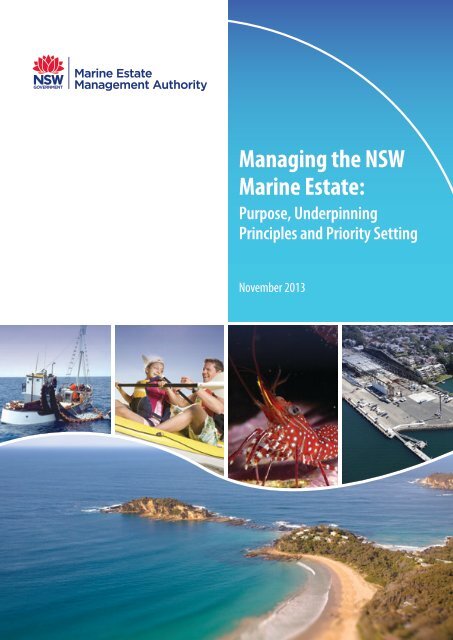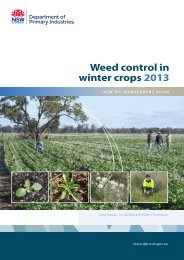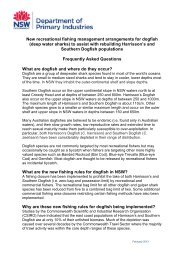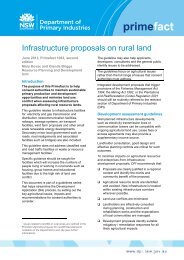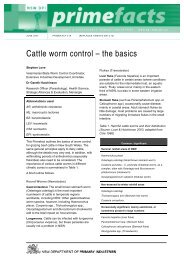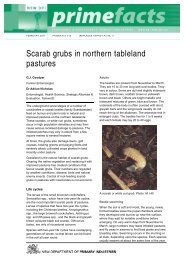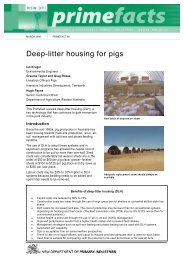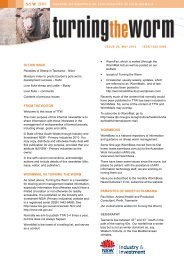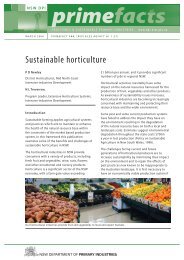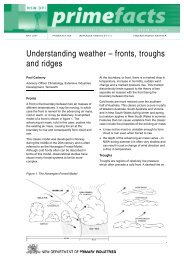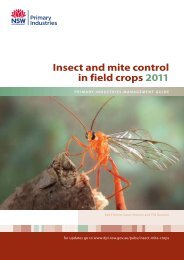Managing the NSW Marine Estate - NSW Department of Primary ...
Managing the NSW Marine Estate - NSW Department of Primary ...
Managing the NSW Marine Estate - NSW Department of Primary ...
Create successful ePaper yourself
Turn your PDF publications into a flip-book with our unique Google optimized e-Paper software.
<strong>Managing</strong> <strong>the</strong> <strong>NSW</strong><br />
<strong>Marine</strong> <strong>Estate</strong>:<br />
Purpose, Underpinning<br />
Principles and Priority Setting<br />
November 2013
Published by <strong>the</strong> <strong>Marine</strong> <strong>Estate</strong> Management Authority, <strong>NSW</strong>:<br />
1. Dr Wendy Craik AM (Chair)<br />
2. Director General, <strong>NSW</strong> <strong>Department</strong> <strong>of</strong> Trade and Investment, Regional Infrastructure & Services<br />
(<strong>NSW</strong> Trade & Investment)<br />
3. Chief Executive, Office <strong>of</strong> Environment and Heritage<br />
4. Director General, <strong>Department</strong> <strong>of</strong> Planning & Infrastructure<br />
5. Director General, Transport for <strong>NSW</strong><br />
6. Chair, <strong>Marine</strong> <strong>Estate</strong> Expert Knowledge Panel - Dr Andrew Stoeckel<br />
Disclaimer<br />
The principles in this document are <strong>the</strong> views <strong>of</strong> <strong>the</strong> <strong>Marine</strong> <strong>Estate</strong> Management Authority. The Authority’s<br />
current status is as a non-statutory Ministerial advisory body. This document has not been endorsed by <strong>the</strong><br />
<strong>NSW</strong> Government.<br />
Acknowledgements<br />
The Authority acknowledges <strong>the</strong> key contribution <strong>of</strong> experts and departmental <strong>of</strong>ficers:<br />
• The <strong>Marine</strong> <strong>Estate</strong> Expert Knowledge Panel<br />
1. Dr Andrew Stoeckel, Chair<br />
2. Dr Kate Brooks<br />
3. Dr Neil Byron<br />
4. Dr Rick Fletcher<br />
5. Associate Pr<strong>of</strong>essor Emma Johnston<br />
6. Peter McGinnity<br />
• <strong>NSW</strong> Trade & Investment including <strong>the</strong> Strategic Policy & Economics Unit<br />
• <strong>NSW</strong> <strong>Department</strong> <strong>of</strong> <strong>Primary</strong> Industries including Fisheries <strong>NSW</strong><br />
• <strong>NSW</strong> Office <strong>of</strong> Environment and Heritage<br />
• <strong>NSW</strong> <strong>Department</strong> <strong>of</strong> Planning & Infrastructure<br />
• Transport for <strong>NSW</strong><br />
Photos courtesy <strong>of</strong> <strong>Department</strong> <strong>of</strong> Planning and Infrastructure, Office <strong>of</strong> Environment and Heritage,<br />
Transport for <strong>NSW</strong>, <strong>Department</strong> <strong>of</strong> <strong>Primary</strong> Industries, Duncan Paterson and Simon Kaminskas.<br />
ISBN 978 1 74256 567 5<br />
Available on <strong>the</strong> internet at www.marine.nsw.gov.au<br />
Enquiries regarding this document should be directed to contact.us@marine.nsw.gov.au<br />
TRIM reference INT13/78219<br />
JN12273 OCT2013
PREFACE<br />
“The <strong>NSW</strong> <strong>Marine</strong> <strong>Estate</strong> is owned by all people and has to be managed for all people…this is not a simple task with<br />
simple solutions…” (Report <strong>of</strong> <strong>the</strong> Independent Scientific Audit <strong>of</strong> <strong>Marine</strong> Parks in <strong>NSW</strong>, 2012).<br />
Almost six million people live within 50 kilometres <strong>of</strong> <strong>the</strong> <strong>NSW</strong> coastline. They and <strong>the</strong> rest <strong>of</strong> <strong>the</strong> <strong>NSW</strong> community<br />
plus <strong>the</strong> millions <strong>of</strong> domestic and international visitors enjoy <strong>the</strong> significant natural assets <strong>of</strong> <strong>the</strong> <strong>Marine</strong> <strong>Estate</strong> and<br />
generate billions <strong>of</strong> dollars each year for <strong>NSW</strong> and <strong>the</strong> Australian community. There are many varied commercial,<br />
recreational and lifestyle uses <strong>of</strong> <strong>the</strong> coast and adjacent seas – <strong>the</strong> <strong>Marine</strong> <strong>Estate</strong>.<br />
To maximise its current and future economic, social and environmental value for <strong>the</strong> community as a whole, we need<br />
to keep <strong>the</strong> coast and sea healthy. To achieve this, <strong>the</strong> <strong>NSW</strong> Government accepted <strong>the</strong> intent <strong>of</strong> <strong>the</strong> Audit Report.<br />
The Government established <strong>the</strong> <strong>Marine</strong> <strong>Estate</strong> Management Authority, which has direct access to independent<br />
expertise through <strong>the</strong> <strong>Marine</strong> <strong>Estate</strong> Expert Knowledge Panel, to advise on policies, priorities and directions for <strong>the</strong><br />
<strong>NSW</strong> <strong>Marine</strong> <strong>Estate</strong>. The <strong>Marine</strong> <strong>Estate</strong> is to be managed as a single continuous system for <strong>the</strong> greatest well-being <strong>of</strong><br />
<strong>the</strong> community.<br />
The <strong>NSW</strong> Government has asked <strong>the</strong> Authority to develop an overarching <strong>Marine</strong> <strong>Estate</strong> Management Strategy and<br />
to undertake a number <strong>of</strong> specific projects on <strong>the</strong> way to developing that strategy. This paper outlines principles and<br />
processes that will be followed in providing advice to <strong>the</strong> <strong>NSW</strong> Government.<br />
For each project, <strong>the</strong> Authority will seek <strong>the</strong> advice <strong>of</strong> <strong>the</strong> independent Expert Knowledge Panel. The Panel has<br />
economic, social and environmental as well as public policy and management expertise. The Panel’s advice to <strong>the</strong><br />
Authority will be made public.<br />
Each project will start by looking at <strong>the</strong> existing evidence. As <strong>the</strong> <strong>Marine</strong> <strong>Estate</strong> is largely a resource owned by <strong>the</strong><br />
public, understanding <strong>the</strong> community’s values (economic, social and environmental) for <strong>the</strong> <strong>Estate</strong> is a critical early<br />
step. We understand that clarity and simplicity are essential in <strong>the</strong> analysis and communication <strong>of</strong> those values, <strong>the</strong><br />
threats to those values and developing <strong>the</strong> most cost effective responses.<br />
To assess <strong>the</strong> threats and risks to <strong>the</strong> community’s values, <strong>the</strong> Authority is developing a threat and risk assessment<br />
framework on <strong>the</strong> advice <strong>of</strong> <strong>the</strong> Expert Knowledge Panel. This framework will continue to be refined on <strong>the</strong> basis <strong>of</strong><br />
experience and feedback.<br />
Recognising that management arrangements are already in place in many areas, existing rights will be respected.<br />
Over time, however, <strong>the</strong>y will be assessed to determine if <strong>the</strong>y are delivering <strong>the</strong> best outcome for <strong>the</strong> community.<br />
The multiple objectives enshrined in <strong>the</strong> <strong>NSW</strong> Government’s vision means that trade-<strong>of</strong>fs will need to be made<br />
between activities. The best available evidence will be used, but where <strong>the</strong>re are knowledge gaps, judgement will<br />
be still required. This will be assisted by analysis <strong>of</strong> <strong>the</strong> costs and benefits to <strong>the</strong> community <strong>of</strong> alternative activities.<br />
Identified knowledge gaps will guide future research to improve our decision making. Measuring <strong>the</strong> condition <strong>of</strong><br />
<strong>the</strong> <strong>NSW</strong> <strong>Marine</strong> <strong>Estate</strong> will be critical to ensure accountability and to enable management to respond to changes in<br />
<strong>the</strong> environment.<br />
MANAGING THE <strong>NSW</strong> MARINE ESTATE: PURPOSE, UNDERPINNING PRINCIPLES AND PRIORITY SETTING<br />
| i
The Authority will make recommendations to <strong>the</strong> <strong>NSW</strong> Government. These will relate to management, research and<br />
improved coordination. These will also be made public. The Government’s response to <strong>the</strong>se recommendations will<br />
be implemented by <strong>NSW</strong> agencies and departments.<br />
The Authority and Expert Knowledge Panel look forward to working with <strong>the</strong> people <strong>of</strong> <strong>NSW</strong> to provide sound advice<br />
to <strong>the</strong> Government on how its valuable <strong>Marine</strong> <strong>Estate</strong> can best be managed for current and future generations.<br />
<strong>Managing</strong> <strong>the</strong> <strong>Marine</strong> <strong>Estate</strong> as an integrated entity represents a new chapter in coastal and marine management<br />
in <strong>NSW</strong>.<br />
Wendy Craik AM<br />
Chair, <strong>Marine</strong> <strong>Estate</strong> Management Authority<br />
ii |<br />
MANAGING THE <strong>NSW</strong> MARINE ESTATE: PURPOSE, UNDERPINNING PRINCIPLES AND PRIORITY SETTING
TABLE OF CONTENTS<br />
Preface<br />
i<br />
1. The <strong>NSW</strong> <strong>Marine</strong> <strong>Estate</strong> 1<br />
2. A Vision for <strong>the</strong> <strong>NSW</strong> <strong>Marine</strong> <strong>Estate</strong> 3<br />
3. Underpinning Principles for <strong>Managing</strong> <strong>the</strong> <strong>NSW</strong> <strong>Marine</strong> <strong>Estate</strong> 4<br />
4. Putting <strong>the</strong> Principles into Practice 8<br />
4.1. A logical sequence <strong>of</strong> steps to maximise community benefits 8<br />
4.2. The threat and risk assessment framework 9<br />
4.3. Assessing and implementing management options 12<br />
4.4. Being accountable 14<br />
MANAGING THE <strong>NSW</strong> MARINE ESTATE: PURPOSE, UNDERPINNING PRINCIPLES AND PRIORITY SETTING<br />
| iii
1. The <strong>NSW</strong> <strong>Marine</strong> <strong>Estate</strong><br />
The <strong>NSW</strong> <strong>Marine</strong> <strong>Estate</strong> is a valuable asset that belongs to <strong>the</strong> people <strong>of</strong> <strong>NSW</strong>. It comprises tidal rivers and<br />
estuaries, <strong>the</strong> shoreline, <strong>the</strong> submerged lands and <strong>the</strong> waters (out to three nautical miles) <strong>of</strong> <strong>the</strong> <strong>NSW</strong> coast from<br />
<strong>the</strong> Queensland to <strong>the</strong> Victorian borders and includes <strong>the</strong> <strong>of</strong>fshore Lord Howe Island. The <strong>Estate</strong> is a narrow ribbon<br />
between Commonwealth waters to <strong>the</strong> east and <strong>the</strong> mainland to <strong>the</strong> west.<br />
Nearly 6 million people or 85 per cent <strong>of</strong> <strong>the</strong> <strong>NSW</strong> population live within 50 kilometres <strong>of</strong> <strong>the</strong> <strong>NSW</strong> coastline. As well<br />
as three major cities - Sydney, Newcastle and Wollongong - and large urban developments in several regions on <strong>the</strong><br />
north coast, <strong>the</strong> <strong>Estate</strong> includes hundreds <strong>of</strong> towns and villages scattered along <strong>the</strong> coast and hinterland.<br />
The <strong>NSW</strong> <strong>Marine</strong> <strong>Estate</strong> is also a haven for domestic and international tourists, receiving over ten million visitors<br />
each year. It provides enjoyment for millions <strong>of</strong> people, including recreational boaters, divers, surfers, swimmers and<br />
fishers and supports a diverse commercial fishing industry.<br />
The <strong>NSW</strong> <strong>Marine</strong> <strong>Estate</strong> has multiple uses 1 and associated benefits that contribute to <strong>the</strong> community’s well-being.<br />
It <strong>of</strong>fers a nationally significant source <strong>of</strong> commercial and research activity, resource conservation and social<br />
enjoyment. These uses, which involve various forms <strong>of</strong> access to <strong>the</strong> <strong>Marine</strong> <strong>Estate</strong>, generate significant economic,<br />
social and environmental benefits, including cultural and traditional use benefits.<br />
Alternative uses can, however, compete with each o<strong>the</strong>r and come into direct conflict, such as commercial and<br />
recreational fishing, or boating and swimming. They can also present threats to <strong>the</strong> economic, social and<br />
environmental benefits <strong>of</strong> <strong>the</strong> <strong>Estate</strong> with <strong>the</strong> potential to impose costs on <strong>the</strong> broader community. For example,<br />
much <strong>of</strong> <strong>the</strong> water run-<strong>of</strong>f from housing, industry and agriculture along <strong>the</strong> coastal strip ends up in <strong>the</strong> ocean. O<strong>the</strong>r<br />
threats include rising water temperatures, ocean acidification and invasive species. Some <strong>of</strong> <strong>the</strong>se threats can be<br />
managed, whereas o<strong>the</strong>rs can only be observed and adapted to.<br />
Stretching north-south for approximately<br />
1250 kilometres, <strong>the</strong> <strong>NSW</strong> <strong>Marine</strong> <strong>Estate</strong><br />
is home to a vast variety <strong>of</strong> marine life,<br />
ecosystems and natural resources. The coast<br />
has 755 ocean beaches that make up 62<br />
per cent <strong>of</strong> <strong>the</strong> shoreline; <strong>the</strong> o<strong>the</strong>r 39 per<br />
cent is rocky outcrops and headlands. There<br />
are 5 major embayments and in total 179<br />
large and medium-sized estuaries. There are<br />
currently six large marine parks, 12 smaller<br />
aquatic reserves and many marine and<br />
estuarine habitats within national parks and<br />
nature reserves that contribute to <strong>the</strong> <strong>NSW</strong><br />
marine protected area system.<br />
1 This term also includes non-exploitive activities, such as biodiversity conservation.<br />
MANAGING THE <strong>NSW</strong> MARINE ESTATE: PURPOSE, UNDERPINNING PRINCIPLES AND PRIORITY SETTING | 1
Because <strong>the</strong> <strong>NSW</strong> <strong>Marine</strong> <strong>Estate</strong> is in many ways an ‘open access’ resource from which <strong>the</strong> community derives a wide<br />
variety <strong>of</strong> benefits at different times and places, several things follow:<br />
• All <strong>NSW</strong> citizens are entitled to have a say in how <strong>the</strong> <strong>Estate</strong> is used and managed to achieve <strong>the</strong> best outcomes<br />
for <strong>the</strong> community as a whole. Broad community input is <strong>the</strong>refore vital, as well as input from special interest<br />
stakeholders.<br />
• Without careful and effective management, impacts from unconstrained access to <strong>the</strong> <strong>Estate</strong> can be different<br />
from <strong>the</strong> outcomes desired by <strong>the</strong> broader community. For example, individuals or businesses using <strong>the</strong> <strong>Estate</strong><br />
may not bear <strong>the</strong> full social cost <strong>of</strong> <strong>the</strong>ir activities, leading to parts <strong>of</strong> <strong>the</strong> <strong>Estate</strong> being damaged. Examples<br />
include over-fishing or pollution from water run-<strong>of</strong>f. This problem is a frequent one for resources that are<br />
collectively owned and is <strong>of</strong>ten described as <strong>the</strong> ‘tragedy <strong>of</strong> <strong>the</strong> commons’. Fur<strong>the</strong>rmore, because <strong>the</strong> oceans<br />
and estuaries are complex biological systems, damage can be irreversible.<br />
• Similarly, individuals or businesses will <strong>of</strong>ten be unable to capture sufficient value from investments aimed at<br />
enhancing <strong>the</strong> benefits <strong>the</strong> <strong>Estate</strong> provides. In <strong>the</strong> absence <strong>of</strong> effective management, this can lead to underinvestment<br />
in maintaining and enhancing <strong>the</strong> <strong>NSW</strong> <strong>Marine</strong> <strong>Estate</strong>. This opens up opportunities for coordinated<br />
government and community action to enhance economic, social and environmental outcomes, such as<br />
investments in research to better understand factors influencing marine ecosystems, or investments in coastal<br />
infrastructure that enable more sustainable beach, estuary and ocean access by local communities and tourists.<br />
Careful and effective management <strong>of</strong> <strong>the</strong> <strong>NSW</strong> <strong>Marine</strong> <strong>Estate</strong> is <strong>the</strong>refore required to align private incentives<br />
with broader community preferences and outcomes, to ameliorate threats and balance competing uses. Various<br />
government bodies and agencies already play a crucial role in providing this management function, including<br />
<strong>the</strong> Office <strong>of</strong> Environment & Heritage, <strong>the</strong> <strong>Department</strong> <strong>of</strong> <strong>Primary</strong> Industries, <strong>the</strong> <strong>Department</strong> <strong>of</strong> Planning &<br />
Infrastructure, Transport for <strong>NSW</strong>, <strong>the</strong> Environment Protection Authority and local government.<br />
The <strong>NSW</strong> Government has recently established <strong>the</strong> <strong>NSW</strong> <strong>Marine</strong> <strong>Estate</strong> Management Authority supported by a<br />
<strong>Marine</strong> <strong>Estate</strong> Expert Knowledge Panel (see diagram on page 15) to work with <strong>the</strong>se agencies and <strong>the</strong> community<br />
toward a common Vision. The Authority and Expert Knowledge Panel will assist in ensuring that policies and<br />
programs address priority issues, are well-coordinated, efficient and evidence-based and result in positive outcomes.<br />
Management priorities will reflect <strong>NSW</strong> 2021: A Plan to make <strong>NSW</strong> Number One 2 objectives and be consistent with<br />
o<strong>the</strong>r key <strong>NSW</strong> Government initiatives, such as <strong>the</strong> new planning system being developed for <strong>NSW</strong> and <strong>the</strong> <strong>NSW</strong><br />
transport master plan. 3<br />
Starting with a Vision for <strong>the</strong> <strong>NSW</strong> <strong>Marine</strong> <strong>Estate</strong>, this paper outlines <strong>the</strong> principles <strong>the</strong> Authority will use to formulate<br />
advice regarding <strong>the</strong> management <strong>of</strong> <strong>the</strong> <strong>Estate</strong> and associated priority setting. In establishing <strong>the</strong>se principles,<br />
<strong>NSW</strong> partner agencies also recognise that <strong>the</strong> <strong>Estate</strong> cannot be managed in isolation from consideration <strong>of</strong> pressures<br />
from neighbouring coastal lands and Commonwealth waters.<br />
2 http://www.2021.nsw.gov.au/<br />
3 http://www.planning.nsw.gov.au/a-new-planning-system-for-nsw ; http://www.transport.nsw.gov.au/sites/default/files/b2b/<br />
publications/nsw-transport-masterplan-final.pdf<br />
2 |<br />
MANAGING THE <strong>NSW</strong> MARINE ESTATE: PURPOSE, UNDERPINNING PRINCIPLES AND PRIORITY SETTING
2. A Vision for <strong>the</strong> <strong>NSW</strong> <strong>Marine</strong> <strong>Estate</strong><br />
In light <strong>of</strong> <strong>the</strong> <strong>NSW</strong> Government’s response to <strong>the</strong> findings <strong>of</strong> <strong>the</strong> 2012 Independent Scientific Audit <strong>of</strong> <strong>Marine</strong> Parks<br />
in <strong>NSW</strong>, 4 <strong>the</strong> Vision for <strong>the</strong> <strong>Marine</strong> <strong>Estate</strong> is to have a healthy coast and sea, managed for <strong>the</strong> greatest well-being<br />
<strong>of</strong> <strong>the</strong> community, now and into <strong>the</strong> future. This Vision encapsulates <strong>the</strong> three key elements <strong>of</strong> managing <strong>the</strong><br />
<strong>NSW</strong> <strong>Marine</strong> <strong>Estate</strong> to maintain and enhance <strong>the</strong> <strong>Estate</strong>’s natural assets while allowing access and use in a way that<br />
maximises economic, social and environmental benefits to <strong>the</strong> people <strong>of</strong> <strong>NSW</strong>, over <strong>the</strong> long-term.<br />
Healthy coast and sea,<br />
managed for <strong>the</strong> greatest well-being <strong>of</strong><br />
<strong>the</strong> community,<br />
now and into <strong>the</strong> future<br />
n clean and safe waters<br />
n biologically diverse and resilient ecosystems<br />
n accessible to <strong>the</strong> community<br />
n maximum economic, social and environmental benefits<br />
n key community benefits maintained and enhanced for<br />
current and future generations<br />
The Vision and associated goals to be achieved – biologically diverse and resilient ecosystems and maximum social,<br />
economic and environmental benefits – provide <strong>the</strong> basis for developing performance measures against which<br />
progress toward our Vision can be assessed.<br />
Multiple benefits are derived from <strong>the</strong> various forms <strong>of</strong> access that are allowed within <strong>the</strong> <strong>Estate</strong> and it is inevitable<br />
that to achieve <strong>the</strong> Vision, trade-<strong>of</strong>fs will continue to be made between competing or mutually exclusive uses and<br />
outcomes. The balance struck may be different in different places and at different geographic scales (local, regional<br />
and state), but with <strong>the</strong> overall objective <strong>of</strong> maximising benefits to <strong>the</strong> people <strong>of</strong> <strong>NSW</strong>. Consideration <strong>of</strong> impacts on<br />
particular groups, such as an industry or a local community, will occur within this broader context.<br />
Much <strong>of</strong> what follows focuses on how <strong>the</strong> <strong>NSW</strong> community will be engaged in <strong>the</strong>se ‘balance’ decisions and how key<br />
knowledge gaps will be managed, such as uncertainty about how marine ecological systems work, <strong>the</strong> nature and<br />
extent <strong>of</strong> future environmental changes, <strong>the</strong> effectiveness <strong>of</strong> management regimes and <strong>the</strong> benefits society derives<br />
from different management options.<br />
There is no escaping <strong>the</strong> fact that judgement will be required, but <strong>the</strong>se judgements will be informed by <strong>the</strong><br />
best available economic, social and environmental information at <strong>the</strong> local, regional and state-wide levels that<br />
can be brought to bear at <strong>the</strong> time. 5 The principles and processes that will be used by <strong>the</strong> Authority to underpin<br />
management advice and recommendations are outlined in <strong>the</strong> following section. Applying <strong>the</strong>se principles will give<br />
<strong>the</strong> best outcomes at least cost to <strong>the</strong> community.<br />
4 Beeton, RJS, Buxton, CD, Cutbush, GC, Fairwea<strong>the</strong>r, PG, Johnston, EL & Ryan, R (2012) Report <strong>of</strong> <strong>the</strong> Independent Scientific Audit <strong>of</strong> <strong>Marine</strong><br />
Parks in New South Wales, <strong>NSW</strong> <strong>Department</strong> <strong>of</strong> <strong>Primary</strong> Industries and Office <strong>of</strong> Environment and Heritage, <strong>NSW</strong>.<br />
5 Determination <strong>of</strong> ‘best available’ will include consideration <strong>of</strong> matters such as relevance and scientific rigour.<br />
MANAGING THE <strong>NSW</strong> MARINE ESTATE: PURPOSE, UNDERPINNING PRINCIPLES AND PRIORITY SETTING | 3
3. Underpinning Principles for <strong>Managing</strong> <strong>the</strong> <strong>NSW</strong> <strong>Marine</strong> <strong>Estate</strong><br />
1. Effective community engagement to identify and prioritise benefits and threats<br />
A feature <strong>of</strong> common property resources is that <strong>the</strong> incentives faced by individuals can lead to outcomes that<br />
are not in <strong>the</strong> interests <strong>of</strong> <strong>the</strong> broader community.<br />
Two things follow. First, a thorough understanding <strong>of</strong> <strong>the</strong> key community benefits derived from <strong>the</strong> <strong>NSW</strong> <strong>Marine</strong><br />
<strong>Estate</strong> at <strong>the</strong> local, regional and state level is required, as well as threats to those benefits. Information on <strong>the</strong>se<br />
benefits and threats will be achieved through ongoing and effective community engagement and expert<br />
input. A critical component <strong>of</strong> this first step will be to fully understand <strong>the</strong> benefits that <strong>the</strong> <strong>Estate</strong> provides to<br />
indigenous communities and to identify <strong>the</strong> best engagement strategies.<br />
Clear and accessible analysis and interpretation <strong>of</strong> <strong>the</strong>se benefits and threats will build widespread community<br />
understanding <strong>of</strong> <strong>the</strong>ir relative importance and <strong>the</strong>reby encourage effective, ongoing, community input.<br />
Second, a challenge for management is to align <strong>the</strong> incentives faced by individuals with desired community<br />
outcomes. This is fur<strong>the</strong>r explained in Principle 8.<br />
2. Identification <strong>of</strong> priority actions will be based on threat and risk assessment<br />
Management resources are limited. Management effort will <strong>the</strong>refore focus on those areas that make <strong>the</strong> best<br />
improvement to economic, social and environmental benefits for <strong>the</strong> community. It follows that ongoing assessment<br />
<strong>of</strong> <strong>the</strong> threats and associated risks to key community benefits provided by <strong>the</strong> <strong>NSW</strong> <strong>Marine</strong> <strong>Estate</strong> is required.<br />
3. Values will be assigned to enable trade-<strong>of</strong>f decisions between alternative uses <strong>of</strong> <strong>the</strong><br />
<strong>Marine</strong> <strong>Estate</strong><br />
A range <strong>of</strong> approaches will be used to make informed trade-<strong>of</strong>fs between alternative uses <strong>of</strong> <strong>the</strong> <strong>Estate</strong>. When<br />
a trade-<strong>of</strong>f is made, implicitly different values have been assigned to those alternative uses. It is important<br />
<strong>the</strong>refore that <strong>the</strong>re be openness and transparency about <strong>the</strong>se values. Fur<strong>the</strong>rmore, it will be imperative to<br />
have a common ‘value’ basis for comparison across <strong>the</strong> economic, social and environmental benefits associated<br />
with alternative uses.<br />
Many <strong>of</strong> <strong>the</strong> social and environmental benefits provided by marine ecosystems are crucial, but do not have an<br />
obvious value to enable ‘like for like’ comparison. Several dangers arise, decisions may favour outcomes which<br />
do have an obvious value, or community benefits that do not have an obvious value may be arbitrarily assumed<br />
to have a very high value and unnecessarily constrain alternative uses, or may be undervalued and <strong>the</strong>refore<br />
mistakenly considered not necessary to manage.<br />
To make informed and transparent trade-<strong>of</strong>f decisions, values should <strong>the</strong>refore be made explicit from <strong>the</strong><br />
outset, as well as <strong>the</strong> assumptions behind those valuations. Valuation techniques for biodiversity are subject to<br />
ongoing development and now enable us to assign values to benefits that are not obvious. This also applies to<br />
social benefits. 6 However, where values cannot be quantified, qualitative assessments will be provided.<br />
6 A technical paper on valuation techniques and <strong>the</strong>ir appropriate use will be developed by <strong>the</strong> <strong>Marine</strong> <strong>Estate</strong> Expert Knowledge Panel.<br />
4 |<br />
MANAGING THE <strong>NSW</strong> MARINE ESTATE: PURPOSE, UNDERPINNING PRINCIPLES AND PRIORITY SETTING
4. Best available information will be used in trade-<strong>of</strong>f decisions, but judgment will still<br />
be required<br />
Changes to <strong>the</strong> <strong>NSW</strong> <strong>Marine</strong> <strong>Estate</strong>’s biodiversity and <strong>the</strong> community benefits it delivers may not be<br />
immediately obvious, particularly in <strong>the</strong> short-term. There are also considerable current knowledge gaps and<br />
uncertainties about ecosystems, threats and <strong>the</strong> effectiveness <strong>of</strong> alternative management options. It follows<br />
that <strong>the</strong> valuation process outlined above can only ever provide part <strong>of</strong> <strong>the</strong> answer, and while best available<br />
evidence will be used in trade-<strong>of</strong>f decisions, judgment will still be required.<br />
5. The well-being <strong>of</strong> future generations will be considered<br />
Assessment <strong>of</strong> community benefits and costs will explicitly consider <strong>the</strong> well-being <strong>of</strong> future generations. An<br />
important overarching sustainability principle is that future generations have a stake in inheriting an asset<br />
that is at least as valuable as it is for today’s users.<br />
6. Existing access arrangements will be respected<br />
While <strong>the</strong> <strong>NSW</strong> <strong>Marine</strong> <strong>Estate</strong> is largely a common property resource, various access rights and arrangements to<br />
<strong>the</strong> <strong>Estate</strong> already exist including but not limited to seascapes, diving, indigenous access and cultural heritage<br />
including sacred sites and shipwrecks, shipping routes, ports and infrastructure, recreational boating access and<br />
infrastructure, commercial fishing licences and o<strong>the</strong>r entitlements including aquaculture leases and recreational<br />
fishing access including recreational fishing havens. Future management <strong>of</strong> <strong>the</strong> <strong>Estate</strong> will recognise and<br />
respect existing rights and arrangements, but retain <strong>the</strong> option to modify <strong>the</strong>m over time to maximise<br />
community benefits. 7<br />
7. The precautionary principle will be applied<br />
In response to uncertainty and information gaps, <strong>the</strong> precautionary principle will be applied and measures<br />
will be taken to avoid threats <strong>of</strong> unacceptable environmental damage. However, lack <strong>of</strong> full scientific certainty<br />
will not be sufficient reason for postponing action.<br />
This does not equate to a ‘no risk’ approach, but will involve careful evaluation to avoid serious and irreversible<br />
damage to <strong>the</strong> environmental values <strong>of</strong> <strong>the</strong> <strong>Estate</strong> and an assessment <strong>of</strong> <strong>the</strong> risk associated with alternative<br />
management options.<br />
Underlying a precautionary approach is <strong>the</strong> changing nature <strong>of</strong> <strong>the</strong> marine environment, ei<strong>the</strong>r naturally or<br />
from man-made causes, which <strong>the</strong> people <strong>of</strong> <strong>NSW</strong> can do little about. A healthy and resilient marine ecosystem<br />
will, however, be better able to adapt to change and in so doing provide more benefit options for future<br />
generations.<br />
7 Any changes would be consistent with government policy and legislative and legal frameworks associated with defined and legally<br />
recognised property rights.<br />
MANAGING THE <strong>NSW</strong> MARINE ESTATE: PURPOSE, UNDERPINNING PRINCIPLES AND PRIORITY SETTING | 5
8. Efficient and cost-effective management to achieve community outcomes<br />
Addressing challenges such as over-exploitation <strong>of</strong> <strong>the</strong> <strong>Estate</strong> will be a priority. Preference will be given to<br />
addressing <strong>the</strong>se challenges through efficient and cost-effective management programs that align private<br />
incentives and behaviours with results desired by <strong>the</strong> community at relevant scales.<br />
Where government intervention is deemed appropriate, <strong>the</strong> best policy will be <strong>the</strong> one that meets policy goals<br />
most efficiently and at least cost. This will favour policies that directly address <strong>the</strong> causes <strong>of</strong> threats and which<br />
<strong>of</strong>fer choice and flexibility in how outcomes can be achieved. Consistent with best practice, polices that are<br />
simple and involve less regulation will be favoured.<br />
9. Management decisions will be transparent and adjust in response to new information<br />
To ensure transparency in management settings and <strong>the</strong> balance <strong>of</strong> community benefits <strong>the</strong>y aim to achieve,<br />
clear and transparent analyses <strong>of</strong> management options will be made available to inform community input.<br />
Fur<strong>the</strong>rmore, because decisions will <strong>of</strong>ten be made under conditions <strong>of</strong> uncertainty and imperfect information,<br />
management settings will be responsive to new information as it becomes available. Authority and Expert<br />
Knowledge Panel advice will be made public.<br />
10. Management performance will be measured, monitored and reported and<br />
information pursued to fill critical knowledge gaps<br />
Appropriate accountability for management performance will be critical. This will require monitoring, measurement<br />
<strong>of</strong> change and public reporting <strong>of</strong> <strong>the</strong> economic, social and environmental benefits derived from <strong>of</strong> <strong>the</strong> <strong>Estate</strong>.<br />
Monitoring <strong>the</strong> condition and use <strong>of</strong> <strong>the</strong> <strong>Estate</strong> will be necessary. This will be complemented by recommending<br />
strategically targeted research to fill critical knowledge gaps.<br />
Principles for <strong>Managing</strong> <strong>the</strong> <strong>NSW</strong> <strong>Marine</strong> <strong>Estate</strong><br />
Facts Implications/Challenges Principles Applied<br />
The <strong>Estate</strong> is largely an open<br />
access resource<br />
Identify key community benefits (what <strong>the</strong><br />
community wants) from <strong>the</strong> <strong>Estate</strong> and threats<br />
to those benefits<br />
1. Effective community engagement, to identify and inform<br />
key benefits and threats<br />
Management resources are<br />
limited<br />
Multiple benefits are derived<br />
from <strong>the</strong> <strong>Estate</strong><br />
Management effort needs to be directed<br />
to where it produces most benefit to <strong>the</strong><br />
community, for now and into <strong>the</strong> future<br />
Trade-<strong>of</strong>fs between non-complementary uses<br />
will be necessary to maximise overall benefits to<br />
<strong>the</strong> community, now and into <strong>the</strong> future<br />
2. Identification <strong>of</strong> management priorities will be based on<br />
threat and risk assessment<br />
3. To evaluate trade-<strong>of</strong>fs, values will be placed on alternative<br />
uses <strong>of</strong> <strong>the</strong> <strong>Marine</strong> <strong>Estate</strong><br />
4. Best available evidence will be used in trade-<strong>of</strong>f decisions,<br />
but judgment will still be required<br />
5. The well-being <strong>of</strong> future generations will be considered<br />
Some access rights have already been assigned 6. Existing access rights will be respected<br />
6 |<br />
MANAGING THE <strong>NSW</strong> MARINE ESTATE: PURPOSE, UNDERPINNING PRINCIPLES AND PRIORITY SETTING
Facts Implications/Challenges Principles Applied<br />
Knowledge gaps and uncertainty<br />
exist about ecosystems, threats<br />
and <strong>the</strong> effectiveness <strong>of</strong><br />
management<br />
<strong>Marine</strong> ecosystems can be damaged irreversibly 7. The precautionary principle will be applied<br />
Management should be efficient,<br />
transparent and accountable<br />
To maximise community benefits, management<br />
programs will align private incentives and<br />
behaviours with preferred community outcomes<br />
and be as light-handed and least cost as<br />
possible<br />
Monitoring, measurement and clear reporting <strong>of</strong><br />
change in community benefits is required<br />
Management will need to adjust to new<br />
information as it emerges<br />
8. Efficient and cost-effective management to achieve<br />
community outcomes<br />
9. Management decisions will be transparent and adjust in<br />
response to new information<br />
10. Management performance will be measured, monitored<br />
and reported and information pursued to fill critical<br />
knowledge gaps<br />
MANAGING THE <strong>NSW</strong> MARINE ESTATE: PURPOSE, UNDERPINNING PRINCIPLES AND PRIORITY SETTING | 7
4. Putting <strong>the</strong> Principles into Practice<br />
4.1 A logical sequence <strong>of</strong> steps to maximise community benefits<br />
To put <strong>the</strong> Authority’s principles into practice, a logical sequence <strong>of</strong> steps will be followed. The starting point<br />
will be to identify <strong>the</strong> benefits <strong>the</strong> community wants from <strong>the</strong> <strong>NSW</strong> <strong>Marine</strong> <strong>Estate</strong>. These economic, social and<br />
environmental benefits will be established through community engagement, supplemented with expert input.<br />
Once key benefits are established, <strong>the</strong> second step is to identify how and where <strong>the</strong>se benefits are under threat.<br />
Again, this will be established by community input, advice and evidence from experts with specialist knowledge<br />
<strong>of</strong> coasts, waterways and marine ecosystems as well as economic and social systems. Community engagement and<br />
information ga<strong>the</strong>ring and sharing activities will be a key focus for <strong>the</strong> Authority and Expert Knowledge Panel.<br />
Having identified potential threats to <strong>the</strong> <strong>NSW</strong> <strong>Marine</strong> <strong>Estate</strong> that might prevent key benefits from being realised,<br />
it will be necessary to assess <strong>the</strong> risk <strong>the</strong>se threats pose so that management effort can be focused on <strong>the</strong> most<br />
important issues. This step is outlined in more detail in <strong>the</strong> following section, but involves assessing, for each threat,<br />
(i) <strong>the</strong> consequence <strong>of</strong> it occurring and (ii) <strong>the</strong> likelihood that it will occur.<br />
The third step will be to assess <strong>the</strong> adequacy <strong>of</strong> current management settings in managing <strong>the</strong> most significant<br />
risks. A consideration will be whe<strong>the</strong>r <strong>the</strong> risks can in fact be managed (e.g. habitat damage due to coastal<br />
development), or can only be observed and reacted to (e.g. sea temperature rise). The principles outlined earlier<br />
will be applied, but in simple terms it means that <strong>the</strong> least cost management regime that delivers maximum<br />
community benefits will be used. It also means that in a world <strong>of</strong> incomplete knowledge, management will adapt<br />
over time as new information arises.<br />
The final step is to ensure management is accountable for performance. This will require measurement <strong>of</strong><br />
community benefits and reporting <strong>of</strong> progress.<br />
8 |<br />
MANAGING THE <strong>NSW</strong> MARINE ESTATE: PURPOSE, UNDERPINNING PRINCIPLES AND PRIORITY SETTING
Maximising Community Benefits Derived from <strong>the</strong> <strong>NSW</strong> <strong>Marine</strong> <strong>Estate</strong><br />
HOW THE COMMUNITY BENEFITS<br />
FROM THE ESTATE<br />
ASSESS THREATS AND<br />
RISKS TO BENEFITS<br />
ASSESS MANAGEMENT OPTIONS<br />
TO MAXIMISE BENEFITS<br />
IMPLEMENT PREFERRED<br />
MANAGEMENT OPTIONS<br />
BE ACCOUNTABLE<br />
Identify key economic, social and<br />
environmental benefits derived from <strong>the</strong><br />
<strong>Estate</strong><br />
Assess threats in terms <strong>of</strong> reduced economic,<br />
social and environmental benefits<br />
Identify and assess current and potential<br />
management settings<br />
Implement options which maximise overall<br />
benefits to <strong>the</strong> <strong>NSW</strong> community as a whole<br />
Monitor, measure and report on performance<br />
Develop ongoing engagement strategy:<br />
n community consultation<br />
n expert input<br />
n stakeholder surveys<br />
Prioritise threats based on <strong>the</strong>ir likelihood<br />
and consequence and consider relevant scale:<br />
n local<br />
n regional<br />
n state-wide<br />
Apply values to economic, social and<br />
environmental benefits <strong>of</strong> alternative uses.<br />
Assess which options deliver maximum<br />
community benefit.<br />
Identify <strong>the</strong> most efficient and costeffective<br />
management options.<br />
Design measurable performance indicators.<br />
Develop strategic monitoring program to<br />
measure outcomes relative to <strong>the</strong> Vision.<br />
Report transparently to community.<br />
Promote strategic research to inform<br />
management and enhance future outcomes.<br />
4.2 The threat and risk assessment framework<br />
The <strong>NSW</strong> Government has committed to developing a <strong>NSW</strong> <strong>Marine</strong> <strong>Estate</strong> Management Strategy. This strategy will<br />
recognise that effective coastal and marine management needs to be underpinned by evidence in regard to human<br />
activities and o<strong>the</strong>r factors that impact on <strong>the</strong> <strong>Estate</strong>. That evidence will be brought toge<strong>the</strong>r in a threat and risk<br />
assessment framework. 8<br />
Many threats and risks to <strong>the</strong> <strong>NSW</strong> <strong>Marine</strong> <strong>Estate</strong> and <strong>the</strong> community benefits it delivers will be apparent to affected<br />
stakeholders. A primary strategy for identifying threats and risks will <strong>the</strong>refore be community engagement. Not<br />
all threats and risks are, however, obvious to <strong>the</strong> casual observer, such as ocean acidification or climate change.<br />
The processes for identifying threats and risks will <strong>the</strong>refore also include consultation with local and international<br />
experts and strategic scientific observation and measurement.<br />
8 This approach is used by o<strong>the</strong>r marine authorities, such as <strong>the</strong> Great Barrier Reef <strong>Marine</strong> Park Authority, and has been endorsed by <strong>the</strong><br />
<strong>NSW</strong> Government.<br />
MANAGING THE <strong>NSW</strong> MARINE ESTATE: PURPOSE, UNDERPINNING PRINCIPLES AND PRIORITY SETTING | 9
The threat and risk assessment framework will incorporate <strong>the</strong> current state <strong>of</strong> knowledge and will define <strong>the</strong> most important<br />
threats and associated risks, as well as <strong>the</strong> management measures currently in place to address <strong>the</strong>m.<br />
The risks that threats present to any <strong>of</strong> <strong>the</strong> economic, social and environmental benefits provided by <strong>the</strong> <strong>Estate</strong> will be defined<br />
on <strong>the</strong> basis <strong>of</strong> <strong>the</strong> ‘likelihood’ and ‘consequence’ <strong>of</strong> threats. 9 Likelihood refers to <strong>the</strong> expected frequency <strong>of</strong> a given<br />
threat under current management settings. Consequence refers to <strong>the</strong> extent <strong>of</strong> <strong>the</strong> impact <strong>of</strong> that threat under current<br />
management settings.<br />
Risk Matrix<br />
LIKELIHOOD<br />
LEVEL OF RISK<br />
ALMOST CERTAIN<br />
HIGH<br />
LIKELY<br />
POSSIBLE LOW MODERATE<br />
UNLIKELY<br />
RARE<br />
MINIMAL<br />
CONSEQUENCE LEVEL INSIGNIFICANT MINOR MODERATE MAJOR CATASTROPHIC<br />
The risk matrix above illustrates that where a threat has a high consequence and is also likely to occur, it results in a<br />
high risk threat. However, where <strong>the</strong> impact <strong>of</strong> a threat is very low and/or <strong>the</strong> likelihood <strong>of</strong> it being realised is very low,<br />
<strong>the</strong> threat will be considered a low risk.<br />
The outcome <strong>of</strong> <strong>the</strong> threat and risk assessment will be <strong>the</strong> identification <strong>of</strong> those problems that matter <strong>the</strong> most and<br />
pose <strong>the</strong> greatest risk to <strong>the</strong> benefits that <strong>the</strong> <strong>Estate</strong> provides to <strong>the</strong> citizens <strong>of</strong> <strong>NSW</strong>. It will be applied at local, regional<br />
and state-wide levels, as well as over <strong>the</strong> short, medium and long-term. Priorities identified through application <strong>of</strong><br />
<strong>the</strong> threat and risk assessment framework will change over time and be modified in response to new information and<br />
ongoing community input.<br />
This will be critical information to underpin judgments about priorities for government, community and industry<br />
action, and where trade-<strong>of</strong>fs between alternative uses may be required. For illustrative purposes, outcomes from <strong>the</strong><br />
application <strong>of</strong> this approach to <strong>the</strong> Great Barrier Reef are outlined in <strong>the</strong> following two charts. Similar information will<br />
be developed for <strong>the</strong> <strong>NSW</strong> <strong>Marine</strong> <strong>Estate</strong>.<br />
Importantly, this Framework will enable stakeholders to work toge<strong>the</strong>r in understanding <strong>the</strong> major threats to<br />
<strong>the</strong> <strong>NSW</strong> <strong>Marine</strong> <strong>Estate</strong> and where effective management settings are required. It will also enable community-wide<br />
understanding <strong>of</strong> where we have knowledge gaps and where <strong>the</strong>re might be opportunities for productive and<br />
sustainable new investment.<br />
9 Alternative approaches to threat and risk assessment are being assessed and a technical paper will be prepared by <strong>the</strong> Expert Knowledge Panel.<br />
10 |<br />
MANAGING THE <strong>NSW</strong> MARINE ESTATE: PURPOSE, UNDERPINNING PRINCIPLES AND PRIORITY SETTING
Illustrative Example 1: Threats to <strong>the</strong> Great Barrier Reef 10<br />
RARE<br />
UNLIKELY<br />
POSSIBLE<br />
LIKELY<br />
ALMOST CERTAIN<br />
Altered<br />
ocean<br />
currents<br />
Large<br />
oil<br />
spill<br />
Fishing<br />
herbivores<br />
Large<br />
chemical<br />
spill<br />
Exotic<br />
species –<br />
imported bait<br />
Altered<br />
cyclone<br />
activity<br />
Exotic<br />
species –<br />
hull fouling<br />
Coral disease<br />
outbreak<br />
COTS<br />
outbreaks<br />
Grounding<br />
large<br />
vessels<br />
Exotic<br />
species –<br />
ballast water<br />
Exotic<br />
species –<br />
aquaculture<br />
Drupella<br />
outbreak<br />
Poaching<br />
species <strong>of</strong><br />
conservation<br />
concern<br />
Traditional<br />
hunting<br />
Sea<br />
level<br />
rise<br />
Bycatch <strong>of</strong><br />
species <strong>of</strong><br />
conservation<br />
concern<br />
<strong>Marine</strong><br />
debris<br />
Fishing<br />
spawning<br />
aggregations<br />
Boat<br />
strike<br />
Dredging<br />
and spoil<br />
dumping<br />
Grounding<br />
small<br />
vessels<br />
Barriers to<br />
river flow<br />
Snorkelling<br />
and diving<br />
activity<br />
Sea<br />
temperature<br />
rise<br />
Nutrient<br />
run<strong>of</strong>f<br />
Clearing<br />
coastal<br />
habitats<br />
Anchoring<br />
on coral<br />
Physical<br />
fishing<br />
impacts<br />
Fishing<br />
filter<br />
feeders<br />
Small<br />
chemical<br />
spill<br />
Ocean<br />
acidif ication<br />
Pesticides<br />
run<strong>of</strong>f<br />
Fishing<br />
top predators<br />
Sediment<br />
run<strong>of</strong>f<br />
Death <strong>of</strong><br />
discarded<br />
catch<br />
Illegal<br />
f ishing<br />
Vessel<br />
waste<br />
discharge<br />
Fishing<br />
low order<br />
predators<br />
Fishing<br />
detritvores<br />
Small<br />
oil spill<br />
CATASTROPHIC MAJOR MODERATE MINOR INSIGNIFICANT<br />
Level <strong>of</strong> risk<br />
Low risk Medium risk High risk Very high risk<br />
10 Great Barrier Reef <strong>Marine</strong> Park Authority (2009), Great Barrier reef Outlook report 2009, Figure 8.1, p166.<br />
MANAGING THE <strong>NSW</strong> MARINE ESTATE: PURPOSE, UNDERPINNING PRINCIPLES AND PRIORITY SETTING | 11
Illustrative Example 2: Timeframes and Scope <strong>of</strong> Threat 11<br />
WHEN IS AN EFFECT LIKELY TO START?<br />
CURRENT OR NEXT 1–2 YEARS NEXT 10 YEARS NEXT 20 YEARS<br />
Sediment run<strong>of</strong>f<br />
Pesticide run<strong>of</strong>f<br />
Physical fishing impacts<br />
Snorkelling and diving<br />
Ocean acidification<br />
STATEWIDE REGIONAL<br />
LOCAL<br />
WHAT IS THE LIKELY EXTENT OF THE EFFECT?<br />
Level <strong>of</strong> risk<br />
Low risk Medium risk High risk Very high risk<br />
4.3 Assessing and implementing management options<br />
To ensure an effective public policy response, threats and risks to <strong>the</strong> <strong>Estate</strong> will be considered in <strong>the</strong> context<br />
<strong>of</strong> aligning private incentives and behaviours with desired community outcomes. The <strong>NSW</strong> <strong>Marine</strong> <strong>Estate</strong><br />
Management Authority will promote and support ongoing review <strong>of</strong> <strong>the</strong> current portfolio <strong>of</strong> government and nongovernment<br />
management initiatives that focus on correcting <strong>the</strong> <strong>Estate</strong>’s open access resource issues to ensure <strong>the</strong>y<br />
are clearly focussed on <strong>the</strong> most important threats and that <strong>the</strong>y are complementary, efficient and equitable.<br />
The first step in developing effective policies and programs to manage key threats will be to clearly identify <strong>the</strong> cause<br />
<strong>of</strong> <strong>the</strong> problem. As previously discussed, <strong>the</strong> cause will <strong>of</strong>ten be a market failure in <strong>the</strong> form <strong>of</strong> over-exploitation <strong>of</strong><br />
<strong>the</strong> <strong>Estate</strong>’s resources, or conflict between competing uses because <strong>of</strong> <strong>the</strong> <strong>Estate</strong>’s open access characteristics.<br />
Potential management options to address threats at <strong>the</strong> local, regional or statewide level will <strong>the</strong>n be developed and<br />
evaluated. These options may involve not just government regulatory and non-regulatory measures, but may also<br />
include community and industry based programs and campaigns.<br />
Evaluation <strong>of</strong> <strong>the</strong> best management options to address identified threats will involve assessing <strong>the</strong> extent to which<br />
those options maximise net benefits to <strong>the</strong> community at least cost. For example, direct regulation by government<br />
can <strong>of</strong>ten cause unintended and unforseen costs. Consequently, modern public policy principles favour nonregulatory<br />
approaches, with regulation being a last resort. Light-handed intervention is preferred.<br />
11 Great Barrier Reef <strong>Marine</strong> Park Authority (2009), Great Barrier Reef Outlook Report 2009, adapted from Figure 8.2, p168.<br />
12 |<br />
MANAGING THE <strong>NSW</strong> MARINE ESTATE: PURPOSE, UNDERPINNING PRINCIPLES AND PRIORITY SETTING
In selecting and implementing <strong>the</strong> most efficient and equitable management option, it will not always be possible<br />
to achieve improvements in all economic, social and environmental benefits at <strong>the</strong> same time and in <strong>the</strong> same place<br />
and hence trade-<strong>of</strong>f decisions will be needed. In addressing trade-<strong>of</strong>fs between alternative uses <strong>of</strong> <strong>the</strong> <strong>Estate</strong> and <strong>the</strong><br />
benefits <strong>the</strong>y provide, <strong>the</strong> <strong>NSW</strong> <strong>Marine</strong> <strong>Estate</strong> Management Authority will seek to ensure that community benefits<br />
are maximised now and into <strong>the</strong> future. These trade-<strong>of</strong>f situations are represented by management initiatives that<br />
fall in <strong>the</strong> top left and bottom right quadrants <strong>of</strong> <strong>the</strong> diagram below.<br />
It is in <strong>the</strong>se circumstances where <strong>the</strong> application <strong>of</strong> values to <strong>the</strong> benefits generated by <strong>the</strong> <strong>Estate</strong> will be essential.<br />
In conjunction with transparent analysis and community input, this information will enable adjustments consistent<br />
with <strong>the</strong> Vision for <strong>the</strong> <strong>NSW</strong> <strong>Marine</strong> <strong>Estate</strong>.<br />
Trade-<strong>of</strong>fs between alternative uses <strong>of</strong> <strong>the</strong> <strong>Marine</strong> <strong>Estate</strong><br />
LOW ENVIRONMENTAL BENEFITS<br />
HIGH<br />
EXISTING<br />
CONDITION<br />
LOW<br />
ECONOMIC & SOCIAL BENEFITS<br />
HIGH<br />
MANAGING THE <strong>NSW</strong> MARINE ESTATE: PURPOSE, UNDERPINNING PRINCIPLES AND PRIORITY SETTING | 13
4.4 Being accountable<br />
To achieve real change consistent with community preferences and <strong>the</strong> <strong>NSW</strong> <strong>Marine</strong> <strong>Estate</strong> Vision, it will be essential<br />
to consider where we want <strong>the</strong> <strong>Estate</strong> to be in 1-2, 10 and 20 years time, to monitor and measure progress toward<br />
achieving our key goals and to modify management settings over time, as appropriate. It will be important for <strong>the</strong>re<br />
to be community transparency and opportunity for input at each stage <strong>of</strong> <strong>the</strong> management cycle.<br />
Continuous Management Cycle<br />
SET VISION &<br />
OUTCOMES<br />
MONITOR &<br />
MEASURE<br />
TRANSPARENCY &<br />
OPPORTUNITY FOR<br />
COMMUNITY INPUT<br />
MODIFY<br />
MANAGEMENT<br />
SETTINGS<br />
REPORT<br />
14 |<br />
MANAGING THE <strong>NSW</strong> MARINE ESTATE: PURPOSE, UNDERPINNING PRINCIPLES AND PRIORITY SETTING
<strong>Marine</strong> <strong>Estate</strong> Advisory Bodies and Reporting Relationships<br />
<strong>Marine</strong> <strong>Estate</strong> Advisory Bodies and Reporting Relationships<br />
The <strong>NSW</strong> <strong>Marine</strong> <strong>Estate</strong> Management Authority welcomes comment and suggestions<br />
in relation to <strong>the</strong> principles and priority setting processes outlined in this paper<br />
contact.us@marine.nsw.gov.au<br />
20 |<br />
<strong>Managing</strong> <strong>the</strong> n SW <strong>Marine</strong> eState: PurP o S e, u nderP inning PrinciP leS and Priority Setting<br />
The <strong>NSW</strong> <strong>Marine</strong> <strong>Estate</strong> Management Authority welcomes comment and suggestions<br />
in relation to <strong>the</strong> principles and priority setting processes outlined in this paper<br />
contact.us@marine.nsw.gov.au<br />
MANAGING THE <strong>NSW</strong> MARINE ESTATE: PURPOSE, UNDERPINNING PRINCIPLES AND PRIORITY SETTING | 15


